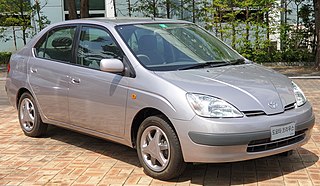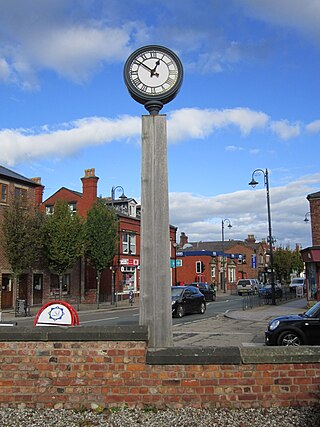
A bogie is a chassis or framework that carries a wheelset, attached to a vehicle—a modular subassembly of wheels and axles. Bogies take various forms in various modes of transport. A bogie may remain normally attached or be quickly detachable ; it may contain a suspension within it, or be solid and in turn be suspended ; it may be mounted on a swivel, as traditionally on a railway carriage or locomotive, additionally jointed and sprung, or held in place by other means.

A locomotive or engine is a rail transport vehicle that provides the motive power for a train. If a locomotive is capable of carrying a payload, it is usually rather referred to as a multiple unit, motor coach, railcar or power car; the use of these self-propelled vehicles is increasingly common for passenger trains, but rare for freight.

A hybrid vehicle is one that uses two or more distinct types of power, such as submarines that use diesel when surfaced and batteries when submerged. Other means to store energy include pressurized fluid in hydraulic hybrids.

An electric vehicle (EV) is a vehicle that uses one or more electric motors for propulsion. It can be powered by a collector system, with electricity from extravehicular sources, or it can be powered autonomously by a battery. EVs include but are not limited to road and rail vehicles, and broadly can also include electric boat and underwater vessels, electric aircraft and electric spacecraft.

An electric locomotive is a locomotive powered by electricity from overhead lines, a third rail or on-board energy storage such as a battery or a supercapacitor. Locomotives with on-board fuelled prime movers, such as diesel engines or gas turbines, are classed as diesel-electric or gas turbine-electric and not as electric locomotives, because the electric generator/motor combination serves only as a power transmission system.

A milk float is a vehicle specifically designed for the delivery of fresh milk. Today, milk floats are usually battery electric vehicles (BEV), but they were formerly horse-drawn floats. They were once common in many European countries, particularly the United Kingdom, and were operated by local dairies. However, in recent years, as the number of supermarkets, small independent grocers and petrol stations, and convenience stores stocking fresh milk has increased, many people have switched from regular home delivery to obtaining fresh milk from these other sources.

A traction motor is an electric motor used for propulsion of a vehicle, such as locomotives, electric or hydrogen vehicles, or electric multiple unit trains.
The Lancashire and Yorkshire Railway (LYR) built suburban electric stock for lines in Liverpool and Manchester. The line between Liverpool to Southport began using electric multiple units (EMUs) on 22 March 1904, using a third rail 625 V DC. Additional trains were later built for this route, and in 1913 incompatible stock for the route to Ormskirk. Lightweight units were built to run on the Liverpool Overhead Railway.

Burscough is a town and civil parish in West Lancashire in the ceremonial county of Lancashire, England. It is located to the north of Ormskirk and northwest of Skelmersdale.

The Ford Ranger EV is a battery electric compact pickup truck that was produced by the Ford Motor Company and was the automaker's first all-electric production vehicle. It was produced starting in the 1998 model year through 2002 and is no longer in production. It is built upon a light truck chassis used in the Ford Explorer. Most vehicles were sold with nickel–metal hydride batteries (NiMH). A few vehicles with lead-acid batteries were sold, but most units were leased for fleet use.

Greenwood & Batley were a large engineering manufacturer with a wide range of products, including armaments, electrical engineering, and printing and milling machinery. They also produced a range of battery-electric railway locomotives under the brand name Greenbat. The works was in Armley, Leeds, UK.

Wingrove & Rogers Ltd of Kirkby, Liverpool, England, was formed in 1919 by Major Charles William Wingrove M.C. (1889-1976) and William Rogers (b1891) to manufacture control gear for electric vehicles. In the 1920s they diversified into variable capacitors, the components essential for tuning in the front end of radio receivers which they continued through the second world war during which they supplied the armed forces. In 1926 they amalgamated with British Electric Vehicles Ltd, and moved the electric vehicle production from Southport to Liverpool where they made vehicles such as electrically motorised trolleys and electric locomotives, largely for use in factories, mines, and by tunnelling contractors.

This is a general list of rolling stock and locomotives currently or formerly on the Groudle Glen Railway on the Isle of Man.

A battery electric vehicle (BEV), pure electric vehicle, only-electric vehicle, fully electric vehicle or all-electric vehicle is a type of electric vehicle (EV) that exclusively uses chemical energy stored in rechargeable battery packs, with no secondary source of propulsion. BEVs use electric motors and motor controllers instead of internal combustion engines (ICEs) for propulsion. They derive all power from battery packs and thus have no internal combustion engine, fuel cell, or fuel tank. BEVs include – but are not limited to – motorcycles, bicycles, scooters, skateboards, railcars, watercraft, forklifts, buses, trucks, and cars.

A mine railway, sometimes pit railway, is a railway constructed to carry materials and workers in and out of a mine. Materials transported typically include ore, coal and overburden. It is little remembered, but the mix of heavy and bulky materials which had to be hauled into and out of mines gave rise to the first several generations of railways, at first made of wooden rails, but eventually adding protective iron, steam locomotion by fixed engines and the earliest commercial steam locomotives, all in and around the works around mines.
The L&YR Class 26 was a class of 20 2-6-2T passenger steam locomotives of the Lancashire and Yorkshire Railway designed by Henry Hoy and introduced in 1903. Most passed to the London, Midland and Scottish Railway (LMS) at the grouping in 1923 though they were withdrawn soon afterwards with none remaining in service after 1926.

Victor Electrics Ltd was a British manufacturer of milk floats and other battery electric road vehicles. The company was formed in 1923 by Outram's Bakery in Southport, Merseyside, to make bread vans for their own use, but they soon diversified into other markets, including the Dairy industry. Their first vehicles had bonnets, like conventional vans, which stored the batteries, but by 1935 all of their vehicles were forward control models, with the cab at the front. They were acquired by Brook Motors in 1967, and became part of the Hawker Siddeley group in 1970. They made a small number of railway locomotives during this latter period.

Harbilt Electrics Trucks was a British manufacturer of milk floats, other battery electric road vehicles and a variety of battery electric vehicles designed for industrial use rather than on the public roads. The company was formed in 1935 in Market Harborough, Leicestershire, and diversified into electric vehicles after the end of the Second World War. They had a good record at exporting their products, with notable successes in Switzerland and California. There were several changes of ownership during the 1970s and 1980s, and the company ceased to exist in 1989.
Tomlinson Electric Vehicles was a British manufacturer of milk floats and other battery electric road vehicles, which also supplied vehicles to the Benelux countries. The company was formed in the mid-1930s. In 1949 they were taken over by King's Motors of Oxford, but the Tomlinson name was retained. They made a battery-electric railway locomotive in 1958, and hoped to diversify into this market, but were the subject of a hostile takeover by an asset stripping company in 1961, after which vehicle production ceased.
















